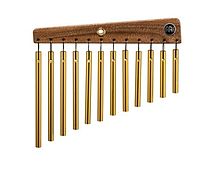Mark tree
This article needs additional citations for verification. (April 2021) |

A mark tree (also known as a nail tree, chime tree, or set of bar chimes) is a percussion instrument used primarily for musical colour. It consists of many small chimes—typically cylinders of solid aluminium or hollow brass tubing 3/8" in diameter—of varying lengths, hung from a bar. They are played by sweeping a finger or stick through the length of the hanging chimes. They are mounted in pitch order to produce rising or falling glissandos.
Unlike
.The mark tree is named after its inventor, studio percussionist Mark Stevens, who devised it in 1967. When he could not come up with a name, percussionist Emil Richards dubbed the instrument the "mark tree".[citation needed] Mark trees are referred to colloquially as wind chimes in modern percussion repertoire, despite starting out as distinctively different instruments with different names. Initially, wind chimes had bars mounted in a circle with a hanging striker strung in the center; they may be solid or hollow and made of many types of material, whereas the mark tree is mounted in a linear fashion and normally has solid metal bars.
The mark tree should not be confused with a similar instrument:
- The bellsmounted vertically along a center post.
See also
- Chime (disambiguation)
- Chime bar
- Glockenspiel
- Tubular bell
- Wind chime
References
- Kalani (2008). All about Hand Percussion: Everything You Need to Know to Start Playing Now!. Alfred Music Publishing. pp. 24–. ISBN 978-0-7390-4964-8.
